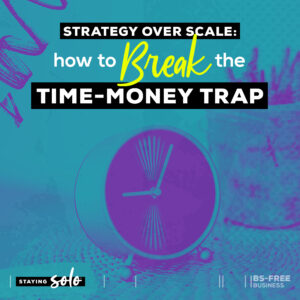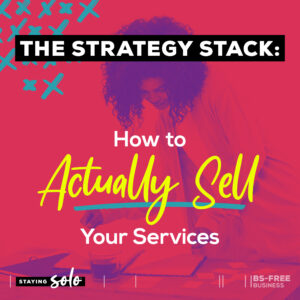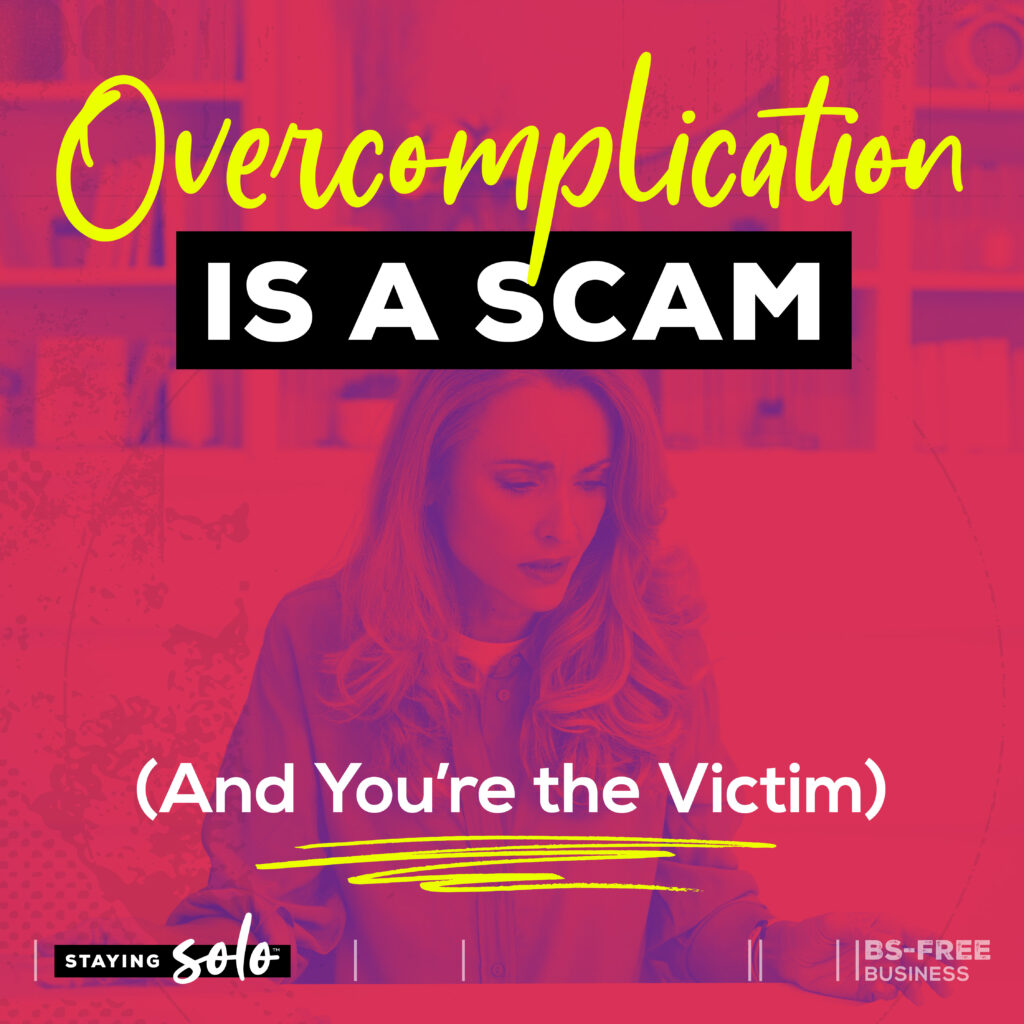
Search the site:
Overcomplication Is a Scam (And You’re the Victim)
Ever found a recipe that sounds simple, 30 minutes, easy ingredients, only to realize you need six things you’ve never heard of, a $20 spice you’ll use once, and a kitchen gadget you don’t own? Three hours later, your kitchen’s a disaster, and you wish you’d just made a grilled cheese.
That’s how most business owners run their businesses, turning something simple into a complicated, time-wasting mess.
Overcomplication is everywhere, and we’ve been tricked into thinking it’s necessary. Celebrity entrepreneurs preach the same nonsense: Add more income streams, be on every platform, and build a 57-step sales funnel!
Meanwhile, you’re drowning in your to-do list, wondering why your business feels chaotic.
Spoiler alert: It’s not you—it’s the scam of overcomplication.
In this episode, we’re breaking it all down—the Chaos Tax you’re unknowingly paying, why complexity isn’t making your business stronger, and how simplicity is the real power move.
If your business feels harder than it should, stick around—this one’s for you.
Celebrity Entrepreneurs Are Personally Victimizing You with This Trash Advice
You’ve probably heard this: Your business needs multiple income streams.
It sounds smart but it leads business owners straight into the overcomplication trap, especially if they’re a team of one.
We’re told that to have a stable business, we need:
- A suite of different offers (low-ticket, mid-tier, VIP… oh, and don’t forget a group program!)
- Passive income streams (because your service business isn’t legit until you have a course)
- A presence on every social platform (because what if you’re missing clients on LinkedIn or TikTok?)
But instead of creating stability, this makes your business a chaotic mess. Trying to juggle a dozen different income streams, marketing strategies, and platforms doesn’t make you more secure—it makes you overworked, overwhelmed, and exhausted.
The people pushing this advice aren’t even running their businesses this way.
Celebrity entrepreneurs? They have full-time employees, ad budgets, and teams to make this work. Their advice isn’t meant for you as a solo service business owner.
Simplicity is the actual safety net.
When your business is simple, it’s more focused, profitable, predictable, and sustainable. But celebrity entrepreneurs don’t want you to know that, as overcomplication serves them.
You don’t need 10 different services or an exhausting content plan to build a thriving business. You need clarity and consistency, both of which come from doing less but doing it better.
This brings us to the real problem: overcomplication is a scam, and it’s time to opt-out.
The Chaos Tax: How Overcomplication Steals Your Time and Money
Entrepreneurs love to make things more complicated than they need to be. And honestly? The business world rewards complexity.
We’re constantly bombarded with advice telling us we need:
- Multiple revenue streams
- A fully optimized sales funnel
- A 10-step email nurture sequence
- A podcast, a YouTube channel, an Instagram strategy, and a LinkedIn presence… oh, and don’t forget TikTok!
No wonder so many business owners are drowning in their to-do lists. Every unnecessary layer of complexity comes at a cost.
And that cost? I call it the Chaos Tax.
It’s the hidden cost of doing too much, overcomplicating everything, and spreading yourself too thin. It doesn’t just drain your time, it steals your money, energy, and ability to focus on what matters.
Here’s how you may be paying the Chaos Tax right now:
- Wasted Time: Endless hours tweaking things that don’t lead to results.
- Missed Revenue: Too many offers and scattered marketing mean no clear sales focus.
- Burnout and Decision Fatigue: More complexity = more decisions = more exhaustion.
- Lost Opportunities: You’re drowning in busy work, so you can’t focus on the big picture.
I always see business owners stacking on more offers, chasing every new marketing trend, or trying to be everywhere online. The result isn’t a more profitable, thriving business—it’s pure chaos.
What happens next isn’t pretty:
- You’re working harder but not getting the results you want.
- You’re constantly jumping from one thing to another.
- And instead of making more money, you’re just making more work for yourself.
Now, let’s get into why simplifying works.
The Business Case for Simplicity
When you simplify your business, magic happens. You get clearer, more focused, and way more effective. Instead of doing 15 things halfway, you do a few things exceptionally well.
The businesses that thrive aren’t trying to be everything to everyone. They have:
- A clear strategy drives every decision, from offers to operations.
- Signature services that set them apart and attract the right clients.
- Specific marketing methods that they excel at, rather than chasing every trend.
- A sales process that converts the right clients efficiently and consistently.
- A pricing model aligned with their value, profit goals, and market positioning.
- Client experience systems that keep clients happy, leading to repeat business and referrals.
When you’re not trying to do everything, you have the bandwidth to deliver amazing client results, refine your strategy, and grow. Instead of scrambling to keep up with too many offers, marketing tactics, or unqualified leads, you get to focus.But simplicity doesn’t happen by accident—it’s an intentional process.
How to Simplify Your Business
Simplicity isn’t about doing less for the sake of it; it’s about sustainably doing the right things.
If your business feels chaotic, overcomplicated, or exhausting, it’s not a sign that you need to work harder—it’s a sign that you need to strip things way back. Here’s how:
Step #1: Get Clear on Your Goals and Priorities
Before cutting things, you must know what you’re working toward. Otherwise, you’ll end up chasing whatever looks good at the moment (hello, shiny object syndrome) instead of making strategic choices that move you forward.
Ask yourself:
- What does success look like for me? More money? More freedom? Fewer clients? A different type of work?
- What are my top two or three priorities right now? Growth? Stability? Improving client experience? Scaling back?
- Where do I want to spend my time? Something must change if most of your day is spent doing things you hate.
This is why Seasons is one of the core pillars of the Staying Solo framework: Your business isn’t static, and your priorities shouldn’t be, either. What you need will shift depending on your energy, capacity, and what’s happening in your work and life.
The key to making smart, strategic decisions is recognizing that your business will evolve and that what worked six months ago might not fit today.
That’s why revisiting your goals and priorities on an ongoing basis is essential. Without checking in regularly, it’s easy to drift into doing things that no longer serve you because they used to make sense.
When you align your decisions with where you are right now, everything becomes clearer. If an opportunity, service, or marketing tactic doesn’t fit your priorities and your season, it’s a no because it’s not the right fit right now.
Step #2: Eliminate the Non-Essential
Now that you’re clear on your goals, it’s time to review your business and cut the clutter.
I recommend you review the five layers of your Strategy Stack, as well as Look at:
- Your services: Which ones are profitable and energizing? Which ones drain you or bring in the wrong clients?
- Your marketing: What’s working, and what’s just keeping you busy? Where are my best clients coming from? What feels easy, and what feels super hard?
- Your time: Where are you spending hours on things that don’t directly lead to results? What’s sucking the life out of you?
If something isn’t moving you closer to your goals—or worse, slowing you down—it’s time to let it go.
Step #3: Fix the Leaks in Your Core Systems
A simplified business isn’t about doing less for the sake of it. It’s about removing unnecessary complexity and making sure your core systems work.
If things feel more complicated than they should, chances are you have leaks in managing money, selling to clients, or delivering services, which are costing you time, energy, and profit.
Enter systems, which are a core pillar of the Staying Solo framework.
And if the word “systems” just made you groan, don’t worry. I’m talking about simple systems that work for you and don’t require 19 pages of documentation.
Here are the three core systems to look at:
System 1: Money Management – Are You in Control of Your Numbers?
When you know your numbers and ensure money moves smoothly through your business, you’re not constantly playing catch-up.
- Are you pricing for profit or just guessing?
- Is cash flow consistent, or are you constantly scrambling?
- Do you have a clear system for invoicing, payments, and expenses?
System 2: Sales & Client Onboarding – Is It Easy for Clients to Say Yes?
Cut unnecessary steps, make your offers clear, and ensure seamless onboarding so new clients can get started without friction.
- Are potential clients confused about how to work with you?
- Is your sales process dragging things out instead of making booking simple?
- Are leads slipping through the cracks because you don’t have a follow-up system?
System 3: Service Delivery – Are You Reinventing the Wheel Every Time?
Create repeatable workflows, so you don’t have to custom-build every project from scratch, and set clear boundaries to prevent scope creep. Establish core communication, project management, and client reporting processes so everything runs smoothly.
- Are projects or retainers taking longer than they should?
- Are clients constantly asking for extras that weren’t in the scope?
- Are you communicating consistently with clients? Do they know what’s happening?
- Do you articulate your boundaries with clients from day one?
Many business owners resist systems because they think they’ll feel restrictive, but sound systems create freedom. They eliminate decision fatigue and cut down on busy work. By tightening up these core areas, you’ll stop the endless hustle, reclaim your time, and finally have a business that works for you—not the other way around.
Say No So You Can Say Yes to the Right Things
At the heart of simplification is one essential skill: saying no.
For many business owners, saying no feels uncomfortable, like turning down money or missing an opportunity. But the truth is that every time you say no to something that doesn’t serve you, you create space for more of what does.
You don’t need to do more; you need to do less, better.
Consider the trade-offs of saying yes to the wrong things:
- Every time you take on a low-paying or misaligned project, you’re losing time you could have spent working with the right clients.
- Whenever you commit to a marketing platform you hate, you drain energy that could be used on something more impactful.
- When you agree to something outside your core expertise, you dilute your brand instead of strengthening it.
If you’re afraid to say no, you need a clear filter for decision-making. Instead of defaulting to yes, ask yourself:
- Does this align with my strengths and expertise?
- Will this move me closer to my goals, or is it just a distraction?
- Am I saying yes out of fear or because it’s the right fit?
Finally, what am I making space for by saying no? When you say no, you’re not rejecting opportunities but choosing better ones.
Simplicity is Your Boring Business Secret Weapon
Overcomplication is a trap. More isn’t better; it’s just busier.
The real power move? Simplification. It’s what makes your business more profitable, more predictable, and way more sustainable.
Your challenge: Find one thing to cut. Maybe it’s a service that drains you, a marketing tactic that’s just busy work, or a process that’s way more complicated than it needs to be. Small changes have a big impact, especially when running a solo service business.
And if this episode gave you the permission slip you needed, pass it along to another business owner who needs to hear it.
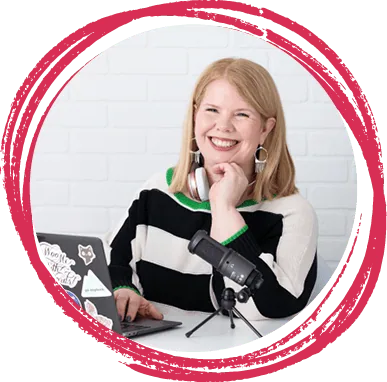
I’m Maggie Patterson (she/her), and services businesses are my business.
I have 20+ years of experience with client services, am a consultant for agency owners, creatives, and consultants, and vocal advocate for humane business practices rooted in empathy, respect, and trust.
Check Out These Posts
For Solo Business Owners
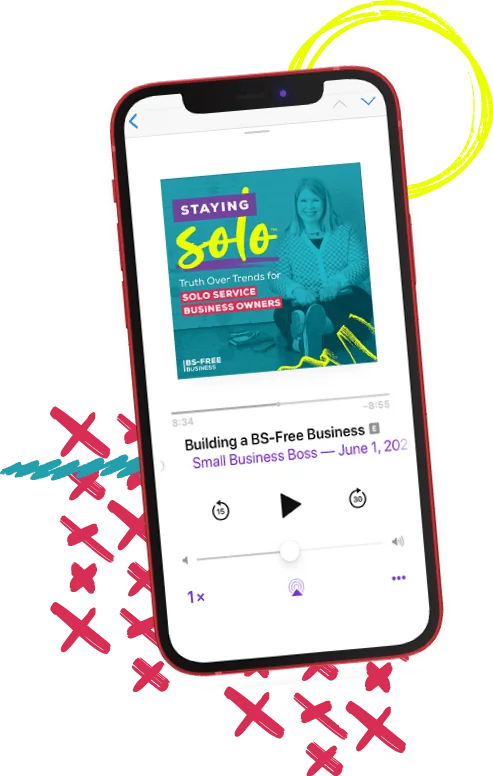
Growing a solo service business is tough.
It’s even harder when you’re bombarded with BS advice that steers you away from your values and why you started your business in the first place.
This is the podcast for solo creatives and consultants who want to remain as a team of one and have zero interest in the hustle and grind of typical business teachings.
Subscribe now and never miss an episode.
For Micro Agency Owners
Most podcasts for agency owners obsess over revenue growth as the ultimate success metric.
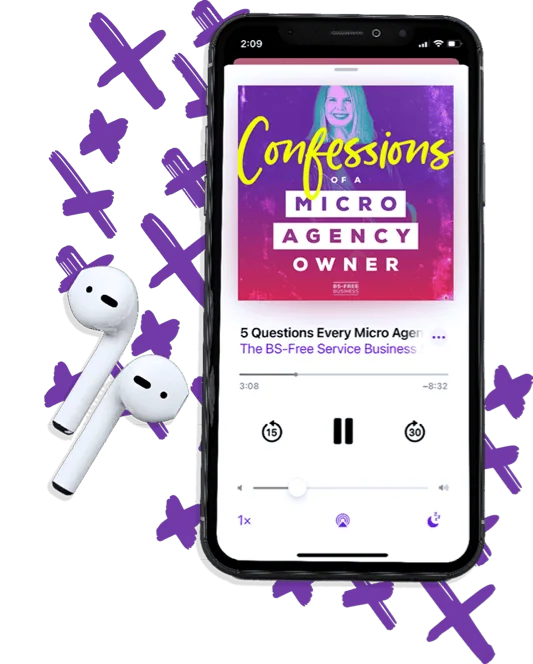
But here’s the truth: not everyone wants to make millions. Your goal might be to build a sustainable business that lets you have a life and doesn’t run you into the ground.
Join me as I spill my shameless confessions and share everything I’ve learned about building a micro agency that skips the BS of tired and typical agency teachings.
Follow Now on All Major Podcast Platforms


